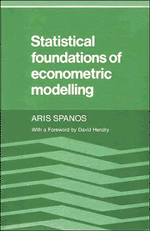Book contents
- Frontmatter
- Contents
- Foreword by David Hendry
- Preface
- Acknowledgements
- List of symbols and abbreviations
- Part I Introduction
- Part II Probability theory
- Part III Statistical inference
- 11 The nature of statistical inference
- 12 Estimation I – properties of estimators
- 13 Estimation II – methods
- 14 Hypothesis testing and confidence regions
- 15* The multivariate normal distribution
- 16* Asymptotic test procedures
- Part IV The linear regression and related statistical models
- References
- Index
11 - The nature of statistical inference
Published online by Cambridge University Press: 01 June 2011
- Frontmatter
- Contents
- Foreword by David Hendry
- Preface
- Acknowledgements
- List of symbols and abbreviations
- Part I Introduction
- Part II Probability theory
- Part III Statistical inference
- 11 The nature of statistical inference
- 12 Estimation I – properties of estimators
- 13 Estimation II – methods
- 14 Hypothesis testing and confidence regions
- 15* The multivariate normal distribution
- 16* Asymptotic test procedures
- Part IV The linear regression and related statistical models
- References
- Index
Summary
Introduction
In the discussion of descriptive statistics in Part I it was argued that in order to be able to go beyond the mere summarisation and description of the observed data under consideration it was important to develop a mathematical model purporting to provide a generalised description of the data generating process (DGP). Motivated by the various results on frequency curves, a probability model in the form of the parametric family of density functions Φ = {f(x; θ), θ ∈ Θ} and its various ramifications was formulated in Part II, providing such a mathematical model. Along with the formulation of the probability model Φ various concepts and results were discussed in order to enable us to extend and analyse the model, preparing the way for statistical inference to be considered in the sequel. Before we go on to consider that, however, it is important to understand the difference between the descriptive study of data and statistical inference. As suggested above, the concept of a density function in terms of which the probability model is defined was motivated by the concept of a frequency curve. It is obvious that any density function f(x; θ) can be used as a frequency curve by reinterpreting it as a non-stochastic function of the observed data. This precludes any suggestions that the main difference between the descriptive study of data and statistical inference proper lies with the use of density functions in describing the observed data. ‘What is the main difference then?’
Information
- Type
- Chapter
- Information
- Statistical Foundations of Econometric Modelling , pp. 213 - 230Publisher: Cambridge University PressPrint publication year: 1986
